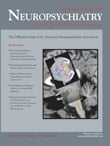To the Editor: While it is agreed that modifying the frequency scoring system would, as the authors suggest, reduce skew, it is not clear how it would improve face validity. The authors argue that face validity is hampered by receiving the same or higher aggression score for many acts of mild aggression as they would for few acts of more severe aggression. This argument is not convincing. The OAS-M items assess aggressive behavior by asking about aggressive behavior, with both more frequent and more severe aggression resulting in higher scores. Thus it is face valid. The relative importance and weighting of different types of acts can be argued, but not as a face validity issue. It should also be noted that individuals with more frequent verbal aggression have been found to have the same level of impairment as those with less frequent physical aggression.
1 The authors also note that the skew created by the current instrument precludes the use of parametric analyses. While the OAS-M, much like the concept it represents, is often skewed in general populations, we have found that the use of transformation has been effective in reducing the skew enough to use parametric measures. It is not clear if the authors have considered this.
There is also some concern that using the frequency scoring system developed to assess lifetime aggression may not be sensitive enough to pick up treatment effect on a weekly measure. For example, going from nine arguments a week to four arguments a week represents a greater than 50% symptom decrease; however, this would be seen as no difference, receiving the same score of 3 using the authors’ scoring system. This is not to argue that a scoring system that reduces skew is not important but rather to suggest that we may need to balance this against measure sensitivity. The authors themselves acknowledge that they failed to find significant treatment effects for the OAS-M in one of the two medication studies they cited.
Though there is a clear relationship between self and other directed aggression, these two constructs are typically thought of as representing distinct, albeit overlapping constructs. We agree that removing aggression against self from the aggression scale would make the scale a more “pure” measure of other-directed aggression. In treatment studies, self-aggression is rarely reported.
2,
3While it is possible that adding a “moderately severe” item may improve the scale in some way, no data are presented to support making this change. The author suggests that this would create more of an interval scale. Five-item Likert scales (the Global Overt Irritability scale is a 6-item Likert scale) are typically treated as interval data. Furthermore, the Global Overt Irritability scale is not a scale unto itself but is combined with the Global Severity Index scale to create an irritability scale that ranges from 0 to 10. If the authors wanted to add another response option to the Global Overt Irritability it is not clear why they would not also add it to the Global Severity Index. Finally, overt aggression (items 1–4) and subjective irritability (item 6) were not designed to be combined.
In summary, improvements to the OAS-M should be based on empirical data directly comparing older and newer versions of the OAS-M showing the newer version to be superior. There is not, at this time, sufficient data to support many of the suggested changes.

